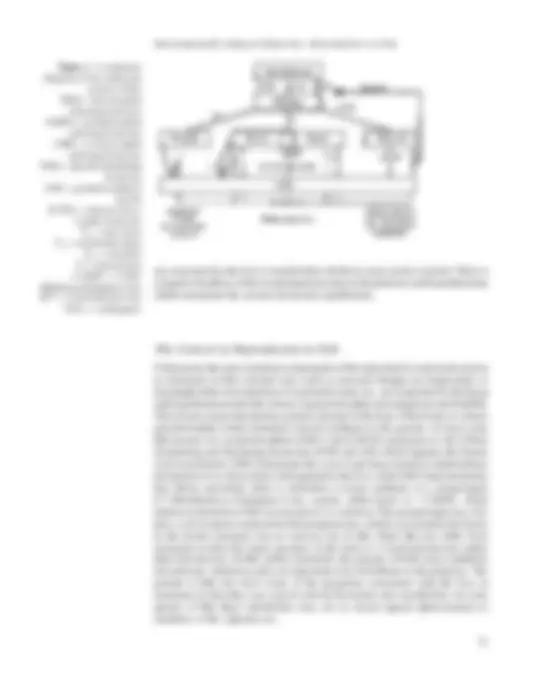
















Study with the several resources on Docsity

Earn points by helping other students or get them with a premium plan


Prepare for your exams
Study with the several resources on Docsity

Earn points to download
Earn points by helping other students or get them with a premium plan
Community
Ask the community for help and clear up your study doubts
Discover the best universities in your country according to Docsity users
Free resources
Download our free guides on studying techniques, anxiety management strategies, and thesis advice from Docsity tutors
A comprehensive overview of endocrine disruption in fish, focusing on the impact of anthropogenic chemicals. It explores various chemicals, their mechanisms of action, and the resulting effects on fish physiology, reproduction, and behavior. The document highlights the importance of understanding endocrine disruption in fish as a critical environmental issue with implications for human health and ecosystem integrity.
Typology: Thesis
1 / 22

This page cannot be seen from the preview
Don't miss anything!















Publication of ‘Silent Spring’ by Rachel Carson in 1962 1 provided a warning of the dangers of the mass spraying of agricultural land with pesticides. The high incidence of dead and dying birds and fish was immediately apparent in areas subjected to this practice, and humans in affected areas were also experiencing symptoms attributable to use of the pesticides. With the cessation of such eradication programmes, which in many cases had not brought about the benefits that had been claimed, it was assumed that the problem had disappeared. Indeed, the birds returned and sang again and fish were once more found in the rivers. For two decades the world became complacent and concentrated on increasing the living standards of a minority of its population in the northern hemisphere. Motor traffic increased in cities, the network of motorways expanded and there was a massive growth in air traffic as world trade and both business and leisure travel expanded. Use of timber pulp for packaging and printing increased greatly, while the innovation of plastics has revolutionised our way of life. Together with the production and disposal of many thousands of different consumer goods, this has resulted, in less than half a century, in the production and release of several hundreds of thousands of synthetic chemicals and the release of abnormally high amounts of many natural chemicals in timber and mining wastes. Whether such release was into the atmosphere, onto land or into the rivers, it all eventually comes to rest in the aquatic ecosystem. Fish, as inhabitants of the rivers, lakes and oceans, inevitably receive the greatest exposures. In areas such as the Great Lakes, the North and Baltic Seas, situated close to areas of high industrial activity, with a relatively low water flow or where sedimentation can occur, fish can be subjected to extremely high exposures. The organochlorine pesticides, which were of greatest concern to Carson, were
1 R. Carson, Silent Spring, Houghton Mifflin, Boston, 1962 (1965 paperback edition, Penguin, Harmondsworth, UK).
Issues in Environmental Science and Technology No. 12 Endocrine Disrupting Chemicals © The Royal Society of Chemistry, 1999
banned in Western Europe and North America in the 1970s, as were the polychlorinated biphenyls (PCBs) widely used as electrical insulators. Both of these classes of chemical are extremely persistent, resisting biodegradation and in many areas their concentrations in fish tissues remain unchanged several decades after production ceased. To these have been added a vast array of other chemicals which may reside in lake, river and ocean sediments for varying periods and that can be metabolised into a wide range of products of unknown toxicity. Except in cases of localised acute pollution, dead fish are now seen much more rarely, but there is increasing evidence that their health is being compromised by long-term low-level pollution. At one level this may lead to premature mortality, resulting in a decreased number of breeding seasons and thence fewer offspring. Evidence is now accumulating, however, that even lower levels of pollutants can disrupt the functioning of the endocrine system of fish, leading to decreases in immune and stress responses, energy metabolism, osmoregulatory ability and reproductive function. 2 Because of their exposure in the aquatic ecosystem, as the major repository of environmental pollutants, fish can provide an early warning of effects that may later become apparent in other wildlife and ultimately in humans themselves. Indeed, there is increasing evidence that some of the problems found in fish, including decreased fertility, genital abnormalities, altered behaviour patterns and response to stress and disease, are now appearing in human populations. 3 This review will summarise the main evidence for such changes in fish exposed both in the laboratory and in polluted habitats to a wide range of the pollutants that now contaminate our environment. References have been kept to the minimum for simplicity and the reader is referred elsewhere 2 for fuller references to much of the data cited.
The aquatic environment is subject to an ever increasing range of man-made (anthropogenic or xenobiotic) pollutants, reflecting the ever more rapid innovations of our technology to manufacture goods to satisfy a perceived increase in consumer demand on which our economy is based. Some of the pollutants that are now present in the tissues of fish, wildlife and humans also reflect past usage of chemicals, such as the organochlorine insecticides and PCBs, which have been banned or restricted in use for several decades. Measurements of tissue concentrations are, however, overwhelmingly limited to a range of pollutants such as pesticides, polyaromatic hydrocarbons (PAHs) and PCBs that are known to be present in the aquatic environment and for which measurement methods do exist. Alkylphenolics and phthalates have only been measured in tissues during the last few years after in vitro studies had shown that they could mimic the action of the natural estrogen estradiol, i.e. they were estrogenic. It cannot be over-emphasised that there are many other xenobiotic chemicals present in the aquatic environment that have never been measured in fish tissue and whose identity and potential endocrine disrupting activity is wholly unknown.
2 D. E. Kime, Endocrine Disruption in Fish, Kluwer, Boston, 1998. 3 T. Colborn, D. Dumanoski and J. P. Myers, Our Stolen Future, Little Brown, London, 1996.
D. E. Kime
malfunction. Tests for endocrine disrupting activity have so far centred on persistent chemicals such as PAHs and PCBs, and the few chemicals like alkylphenolics and phthalates that have been discovered to have endocrine disrupting activity only by chance. High concentrations of these chemicals are found in fish in polluted areas such as the North and Baltic Seas and the Great Lakes. Endocrine dysfunction in fish from such areas has been demonstrated, but cannot simply be causally related to the high levels of these particular chemicals since they are inevitably associated with many of the hundreds of thousands of other chemicals that are released from other industrial processes in the same waterways. Commercial secrecy is a major impediment to identifying and restricting release of endocrine disrupting chemicals. The scale of the problem is exemplified by pesticide formulations in which the active ingredient is mixed with an ‘inert dispersant’. One such widely used ‘inert’ dispersant was the alkylphenolic detergent, which is now known to degrade to persistent and estrogenic products. Measurement of contaminants in fish has concentrated on muscle tissue since the aim has generally been to protect the health of the consumer rather than that of the fish. Endocrine tissue such as the gonads has been much more rarely examined, while data for adrenal, thyroid and pituitary levels are virtually non-existent. More data are available for the liver, as a lipid rich tissue and the major site of xenobiotic catabolism, but the concentrations have rarely been related to its capacity to produce vitellogenin or metabolise endogenous hormones. Tissue concentrations of a wide range of chemicals, 2 are at a level which suggests that, either alone or in combination, they will cause significant endocrine disruption in fish in many polluted habitats.
To fully understand how these pollutants can affect fish at very low levels, it is necessary to outline very briefly how the endocrine system works. It is a control system of the body which responds to internal and external signals to maintain the body in a chemical equilibrium, to regulate sexual development and the seasonal reproductive cycles, and to evoke a stress response to external threats. At its core are the hypothalamus and pituitary, which respond to neural signals from the brain and convert them into hormone messengers which act on the individual glands such as the gonads, the thyroid and the adrenal (Figure 1). The endocrine systems of all vertebrates have essentially the same components, which originated during the early evolution of fish. It is not clear how many of the differences between mammals and fish are due to evolutionary divergence and how much is attributable to the very different habitats in which they have developed. Clearly the regulation of water and mineral balance in the body fluids (osmoregulation) requires very different control in mammals to that of fish inhabiting fresh- or seawater environments, while regulation of reproduction in the predominantly egg-laying (oviparous) fish is very different from that which is required in placental mammals. In many cases it is not the hormones but the uses to which they are put which differs, although some of the steroid hormones in fish do show marked differences to those of mammals. Once they have elicited the appropriate action in their target tissue, hormones
D. E. Kime
Figure 1 A schematic diagram of the endocrine system of fish. TRH \ thyrotrophin releasing hormone; GnRH \ gonadotrophin releasing hormone; CRH \ corticotrophin releasing hormone; TSH \ thyroid stimulating hormone; GtH \ gonadotrophins I and II; ACTH \ adrenocortico- trophic hormone; T 4 \ thyroxine; T 3 \ triiodothyronine; E 2 \ estradiol; T \ testosterone; 17,20bP \ 17,20b- dihydroxy-4-pregnen-3-one; KT \ 11-ketotestosterone; VTG \ vitellogenin.
are converted by the liver to metabolites which are more easily excreted. There is a negative feedback of the circulating hormones to the pituitary and hypothalamus which maintains the normal hormonal equilibrium.
Fish possess the same essential components of the reproductive endocrine system as mammals in that external cues, such as seasonal changes in temperature or daylength, behaviour patterns of a potential mate, etc., are translated by the brain and hypothalamus into the release of gonadotrophin releasing hormone (GnRH). This in turn causes the pituitary gland, situated at the base of the brain, to release gonadotrophin which stimulates steroid synthesis in the gonads. At least some fish possess two gonadotrophins (GtH-I and GtH-II) analogous to the follicle stimulating and luteinising hormones (FSH and LH) which regulate the female cycle in mammals. GtH-I stimulates the ovary to produce estradiol which induces production of a yolk protein (vitellogenin) by the liver, while GtH-II predominates just before spawning when it stimulates ovarian synthesis of a progestogen (17,20b-dihydroxy-4-pregnen-3-one, usually abbreviated to 17,20bP), which induces maturation of the oocytes prior to ovulation. This progestogen may also play a role in sperm maturation but progesterone, which is an essential hormone in the female mammal, has no known role in fish. Male fish also differ from mammals in that the major product of the testis is 11-ketotestosterone rather than testosterone. In fish, unlike mammals, the gonads of both sexes synthesise testosterone, which may play an important role in feedback to the pituitary. The gonads of fish also have some of the properties associated with the liver in mammals in that they can convert steroid hormones into metabolites. In some species of fish these metabolites may act as sexual signals (pheromones) to members of the opposite sex.
Environmentally Induced Endocrine Abnormalities in Fish
included in the definition, but clearly the boundaries of endocrine disruption, like those of endocrinology, cannot be too clearly delineated.
Mechanisms of Endocrine Disruption. Classical toxicology deals with the effects of chemicals which act by causing damage to the function of the animal cell, and as such they have relatively little tissue specificity. Xenobiotics which disrupt the endocrine system, however, can act via a very wide variety of mechanisms. They can mimic the effect of a natural hormone (agonist), or they can block its action (antagonist). This may cause changes in the response to the hormone at its target site by affecting its ability to bind to receptors, affect its feedback action to the higher sites of endocrine control such as the hypothalamus and pituitary, or alter the hormone-dependent behaviour of the exposed animal. They can also affect the action of key enzymes of biosynthesis and metabolism that will alter circulating hormone levels, or cause structural changes which affect the function of an endocrine gland. The complexity of the issue is clearly seen in Figure 1, where disruption of any single component can cause dysfunction of a whole range of inter-related mechanisms.
Fish as Monitors of Endocrine Disruption. Since fish are, perhaps, the class of vertebrate most at risk of endocrine disruption in that their habitat receives the greatest imput of anthropogenic pollution, they might be considered the obvious animal for experimental investigation. Their commercial and dietary importance certainly warrants an investigation of any factors which might lead to a decrease in their populations. In addition, there are some endocrine functions that are far more easily investigated in fish than in mammals. Recent reports in the popular press concentrating on the threat to male fertility posed by environmental estrogens have largely obscured both the fact that female fertility may be equally well compromised and that such effects can be caused by many compounds that are not estrogenic. Although such bias may be attributable to the need to make a good story, or to a male dominated society, they also reflect the fact that males continually produce sperm in extremely large amounts which are physically accessible for research. In contrast, the female mammal releases only a very small number of eggs at infrequent intervals and they are not accessible without invasive surgery. Fish, which can spawn thousands or millions of eggs to the external environment, therefore provide an excellent model with which to examine the effects of endocrine disruptors on female fertility. The high fecundity also makes it much more feasible to examine the effects of such disruptors on embryonic development and on the effects of parental or embryonic exposure on the endocrine function of the offspring. Fish also have a major advantage since it is far easier to give a regular exposure of known concentration via the holding water or diet, and to examine the effects of exposure during defined periods of development or during different phases of the reproductive cycle. The ready availability of small fish such as zebrafish, fathead minnows and medaka with a very short life cycle also makes it much easier to examine the effects of exposure at specific periods on endocrine function over several generations.
Environmentally Induced Endocrine Abnormalities in Fish
The close neural relationship of the hypothalamus and the pituitary gland with the brain makes them particularly vulnerable to neurotoxins such as the organophosphate pesticides and the heavy metals lead and mercury. Although the numbers of studies on these tissues are few, reflecting their very small size and inaccessibility, there is clear evidence that both these heavy metals, and the organochlorine and carbamate pesticides, can damage the neurones of the hypothalamus which are responsible for GnRH release, leading to failure of ovaries and testes to produce yolky eggs and viable sperm. Organochlorine and organophosphate pesticides, cyanide, PAHs, PCBs, cadmium and mercury can all cause degeneration of the secretory cells of the pituitary gland and decrease its release of hormones. 2 Industrial pollutants, such as paper mill effluents, can also affect the responsiveness of the pituitary to GnRH released by the hypothalamus. 6 The feedback signal to the pituitary, which regulates plasma steroid hormone balance, can be disrupted by any xenobiotic that has hormone mimicking properties. Organochlorine pesticides, such as the lindane impurity b-HCH, mimic natural estrogen and induce a negative feedback response in the pituitary. 7 This could account for many of the reports of reproductive failure of fish in waters such as the Great Lakes that are heavily polluted with organochlorines.
Much of the impetus for the recent upsurge in activity on endocrine disruption was the finding of decreased sperm counts and an increased incidence of genital abnormalities in humans. 8 While some of these findings have been disputed, the much more extensive evidence from studies with fish adds considerable weight to the argument that such changes are occurring and that they are caused by exposure to anthropogenic pollutants rather than to changes in human lifestyle during the last few decades. Although the abnormalities in human populations were attributed to ‘environmental estrogens’, and this has been the subject of much popular concern, it is important to realise that there are very many chemicals that affect male reproductive function in fish which have no estrogenic activity. Such chemicals, even if they are not hormone mimics, can either disrupt the activity of the tissues that secrete or metabolise hormones or the receptors for these hormones. A wide variety of chemicals which cause direct changes in endocrine function of isolated tissues can be considered as potential endocrine disruptors, but too frequently there has been a failure to demonstrate that in the intact animal such chemicals act on the endocrine system at concentrations which do not cause either a stress response or are toxic to the animal. Many organochlorine pesticides, for example, are estrogenic, but they also have a very high toxicity and estrogenic action is of little consequence to a dead or dying fish. Even nonylphenol, which has been of such recent concern for its estrogenic
6 G. J. Van der Kraak, K. R. Munkittrick, M. E. McMaster, C. B. Portt and J. P. Chang, T oxicol. Appl. Pharmacol., 1992, 115 , 224. 7 P. W. Wester, J. H. Canton and A. Bisschop, Aquat. T oxicol., 1985, 6 , 271. 8 R. M. Sharpe and N. E. Skakkebaek, L ancet, 1993, B41, 1392.
D. E. Kime
sites, this can be misleading since they may constitute two distinct populations that spawn at different times even if they are not exposed to a pollutant. In rivers, large lakes and oceans there can be significant migrations so that the fish captured in a clean habitat may have been feeding in polluted areas or vice versa. Considerations of spawning migrations are particularly important since early life is one of the most sensitive periods for inducing endocrine disruption and exposure at a polluted spawning ground could lead to abnormalities that only become apparent when the fish is caught later as an adult in clean water perhaps some hundreds of kilometres away. Conversely, fish captured in polluted water may be apparently unaffected because they were spawned in distant clean water. It is also clear that it is difficult to relate cause and effect to any specific chemical since, with the exception of point source effluents, many waterways contain a multitude of chemicals, of which the active endocrine disruptor may not be that which has been measured in the water or tissue. For such reasons, many studies have used in vitro experiments in which isolated tissue, either from a control animal or one captured in a polluted water system, is exposed to a single pollutant in the laboratory. Such experiments have shown significant disruption to testicular activity by a wide range of xenobiotics, including cadmium, lindane, DDT, cythion, hexadrin and PCBs. 2
Although all male vertebrates produce vastly more sperm than eggs, evidence from both fish and mammals suggests that even a small decrease in sperm quality or quantity can decrease the male’s fertilising ability. Viability of sperm in fish, as in other vertebrates, is dependent on the correct hormonal and nutritional environment during their development within the testis. This may in turn be affected by the internal hormonal environment during the early life stages in which the testis is differentiated. Endocrine disruption can therefore lead to abnormal development of the sperm and decrease its viability. This may take the form of either abnormal sperm structure or a decrease in its energy supply, both of which can alter its swimming ability and therefore its capacity to reach and fertilise the egg. Computer technology can now make a quantitative assessment of the effects of xenobiotics on sperm quality and predict fertilisation success. 10 — 12 Recent studies 12 suggest that mercury can cause an instant decrease in the sperm viability of fish at concentrations comparable to those which are permitted in drinking water (1 kg l~1). The bioconcentration of the metal to levels in the testis considerably higher than this from water containing only 1/30 of permitted levels 4 suggests that current legal limits are much too high.
Courtship rituals in fish can involve a complex communication between males
10 D. E. Kime, M. Ebrahimi, K. Nysten, I. Roelants, E. Rurangwa, H. D. M. Moore and F. Ollevier, Aquat. T oxicol., 1996, 36 , 223. 11 G. P. Toth, S. A. Christ, H. W. McCarthy, J. A. Torsella and M. K. Smith, J. Fish. Biol., 1995, 47 , 986. 12 E. Rurangwa, I. Roelants, G. Huyskens, M. Ebrahimi, D. E. Kime and F. Ollevier, J. Fish Biol., 1998, 53 , 402.
D. E. Kime
and females via chemicals released into the surrounding water. These pheromones are, in many cases, the hormones secreted by the gonads and are probably a selective adaptation enabling males to detect females that are ready to spawn. Successful courtship is therefore dependent on the ability of the female to secrete the pheromone, the male to detect it, and for his neural and endocrine system to elicit a response that both triggers his production of sperm and his appropriate sexual behaviour. Carbofuran and the organophosphate diazinon can both disrupt the ability of male fish to detect such pheromones.13,14 Xenobiotics might also cause changes to other aspects of androgen-dependent breeding behaviour, particularly in species in which the male builds or guards a nest or spawning territory. This may be particularly important in species such as the stickleback which produces an androgen stimulated glue from the kidney for nest-building. Development of male secondary sexual characteristics such as the red belly of sticklebacks or the hooked jaw in salmonids is dependent upon testicular secretion of 11-ketotestosterone, and any decrease in production of this steroid or effects on its receptors could inhibit his ability to attract a mate. Such changes can make a useful biomonitor for reduction in testicular function. In mammals, sex-dependent behavioural patterns are imprinted during a very brief period of testicular activity at birth, but such patterns are only expressed at puberty. 15 Nothing is known about whether such patterns are also imprinted in fish, and if so, whether, as in mammals, the sensitive window for such exposure differs from that in which the genitalia become structurally differentiated. In mammals a hormonal imbalance, either natural or xenobiotic induced, during this ‘imprinting’ period can result in behaviour patterns characteristic of the opposite sex. Similarly, the elaborate courtship ritual which is essential to induce ovulation in many fish species could be disrupted by alterations in endocrine function during key early life stages. There have, however, been few studies of the effects of xenobiotics on endocrine mediated behaviour patterns.
Xenobiotic induced disruption of female fertility follows essentially the same pattern as that of the male and can be caused by changes in pituitary—hypothalamic function, primary disruption of ovarian structure or hormone secretion, or changes in the rate of hormone deactivation. In addition, there may be changes in the synthesis of estrogen induced production of the yolk protein by the liver (vitellogenesis), which in turn can lead to failure to lay down sufficient yolk in the developing oocytes. Vitellogenesis provides a valuable biomarker for endocrine dysfunction in both sexes, 16 but is more properly considered as part of the liver function.
13 A. Moore and C. P. Waring, J. Fish Biol., 1996, 48 , 758. 14 C. P. Waring and A. Moore, Fish Physiol. Biochem., 1997, 17 , 203. 15 F. S. Vom Saal, M. M. Montano and M. H. Wang, in Chemically Induced Alterations in Sexual and Functional Development: T he W ildlife/Human Connection, ed. T. Colborn and C. Clement, Princeton Scientific, Princeton, 1992, p. 17. 16 D. E. Kime, J. P. Nash and A. P. Scott, Aquaculture, 1999, 117 , 345.
Environmentally Induced Endocrine Abnormalities in Fish
these xenobiotic inhibitors could have a similar effect and alter the sex ratio of exposed populations.
The majority of the literature on endocrine disruption in fish is concerned with ovarian development, rather than ovulation and spawning. This is undoubtedly due to the difficulty in assessing changes that can occur extremely rapidly during the 1—2 days which precede spawning. Ovulation is stimulated by a range of external stimuli such as the presence of a male and his courtship behaviour, spawning substrate, as well as temperature or water flow. Absence of the correct stimuli is a frequent cause of ovulatory failure in captive fish. Failure to ovulate in the presence of xenobiotics may not therefore be due to true endocrine disruption of the female but to indirect factors which affect the male or to environmental factors such as loss of spawning vegetation. The final maturation of the eggs just prior to ovulation and spawning is dependent on a very rapid change in the pattern of secretion of pituitary and ovarian hormones. Any disruption to this pattern can have major consequences for the ability of the fish to spawn. While long-term exposure to such chemicals would lead to delayed ovarian development, their release into rivers for only a short period that coincided with the spawning period, as occurs for example with organophosphorus sheep dips, could have serious consequences for the future fish population. Such disruption has been observed for the pesticides malathion, phosdrin, gardona and endosulfan. In many waters polluted by PCBs, pulp mill effluents or acid, however, spawning can proceed without difficulty, but is delayed by days or even weeks. 2 Such late spawning is usually a result of decreased steroid production causing slower ovarian development than normal, but even if the full complement of eggs is eventually spawned this delay may have serious consequences for the numbers of offspring which survive to form a breeding population. Fish have evolved so that seasonal cues, mediated by the reproductive endocrine system, ensure that the spawning date is such that eggs will hatch at a time that coincides with a plentiful food supply and/or an absence of predators. Any delay in spawning will therefore decrease the competitive advantage of the young of the species that will both be too small to feed on their natural prey and become the target of other predators. In temperate species it will also lead to lower energy reserves with which to survive the first winter.
Decreased production of yolk protein resulting from inhibition of either ovarian or liver function presents the fish with a similar choice to that resulting from decreased food availability. It can produce the same number of smaller eggs, or a smaller number of eggs of normal size, 23 but the mechanism by which that choice is made is unclear. Since the decreased nutrient content of small eggs will result in smaller larvae with a decreased survival rate, the net result in both cases may be a
23 C. R. Tyler and J. P. Sumpter, Rev. Fish Biol. Fisheries, 1996, 6 , 287.
Environmentally Induced Endocrine Abnormalities in Fish
decreased survival of the progeny. Furthermore, there is evidence that many xenobiotics can be passed on from the mother to the offspring by incorporation into the developing eggs. Although this off-loading of the pollutant burden will decrease its toxicity to the mother, it will inevitably increase the exposure of the developing offspring at critical stages of embryonic development. Since eggs rapidly become impermeable in water after spawning, it is probable that in most cases the embryo receives the majority of the toxicant from its mother rather than directly from the surrounding water. While fertilisation and hatch rates have long formed the basis of many standard toxicity tests owing to the rapidity with which they can be carried out with small fish such as danios and minnows, they also provide valuable information on endocrine disruption. In many cases, abnormal development may be caused by the chemicals interfering with key developmental processes involving cellular signalling mechanisms, rather than by simple toxicity or chromosomal damage. Although the exact mechanism by which embryonic and larval development is controlled is not yet fully understood, it involves both the steroid and thyroid hormones and a range of intra- and intercellular messengers that are now covered by the broader definitions of endocrinology. As a result of the widespread use of early life stages for toxicity testing there is a vast literature on the types of developmental abnormalities which can occur, but so far very little on how much of this is really endocrine disruption and how much simply random toxicity or genetic damage which leads to deformity or mortality. Hatching failure can be due to a multiplicity of causes, but some syndromes of abnormality such as blue-sac disease and the similar PCB-induced M74 syndrome affecting Baltic salmon appear to be surprisingly common, which suggests disruption of key stages of embryonic or larval development. Until the site of action involved can be clarified, and whether the xenobiotic acts via hormonal or cellular signalling can be determined, it must remain open as to whether this can truly be called endocrine disruption. Sexual differentiation is more easily understood since in fish, as in mammals, it is dependent on the internal hormonal environment at critical early life stages. In mammals, both structural differentiation of the gonads and sexual behaviour patterns in adults can be affected by abnormalities in the internal hormonal environment during very early life. 15 Such effects may be more pronounced in fish in which sex determination is more labile. The ‘hermaphrodite’ fish found after exposure to water containing estrogenic alkylphenolics24,25 that have been the subject of recent concern are much more likely to have been the result of pollutants altering the hormonal balance at key stages in early life than to exposure of adult males. Indeed, as long ago as 1986, b-hexachlorocyclohexane (an impurity in the insecticide lindane) was shown to cause an ova-testis in medaka hatched from exposed eggs. 26 Since both alkylphenolics and b-HCH have estrogenic activity, it is probable that such compounds could affect sexual differentiation by mimicking the action of estradiol that might normally be produced by female larvae. Similar effects could also be expected in young fish
24 S. Jobling, M. Nolan, G. Brighty, C. R. Tyler and J. P. Sumpter, Environ. Sci. T echnol., 1998, 32 , 1498. 25 M. A. Gray and C. D. Metcalf, Environ. T oxicol. Chem., 1997, 16 , 1082. 26 P. W. Wester and J. H. Canton, Aquat. T oxicol., 1986, 9 , 21.
D. E. Kime
The hormones of the thyroid, in concert with those of the adrenal gland and growth hormone from the pituitary, regulate energy utilisation, metabolic rate and growth. Since thyroid hormones are incorporated into the developing egg from maternal sources, they may also be involved in larval development, although their role in this is still far from clear. The main thyroid hormones, thyroxine (T 4 ) and triiodothyronine (T 3 ), are tetra- and triiodinated derivatives of 4-hydroxydiphenyl ether and as such have close structural similarities to other planar halogenated aromatic compounds such as PCBs, dioxins and DDT. It is therefore not surprising that such chemicals are those most suspected of inducing thyroid dysfunction by competing for receptors. As in mammals, thyroid function can be disrupted by action of pollutants at several sites, including production of thyrotrophin releasing hormone (TRH) from the hypothalamus, release of thyroid stimulating hormone (TSH) from the pituitary, synthesis of T 4 by the thyroid or its conversion in the thyroid and liver into T 3 (Figure 1). The study of thyroid activity has undoubtedly been inhibited by the difficulty of isolating the tissue which, unlike mammals, does not form a distinct gland but is scattered as isolated cells around the ventral aorta. The most extensive studies of thyroid dysfunction have been of salmon in the Great Lakes where massive goitres, with thyroid enlargements of up to a million million fold, were observed. 30 Goitre is usually attributed to iodine deficiency and loss of negative feedback to the pituitary resulting from failure of the thyroid to synthesise T 3
and T 4
. This was not the case in the Great Lakes, nor was there a direct correlation between tissue PCB levels and the presence of goitres. The Great Lakes, however, contain such a cocktail of chemicals that it is impossible to analyse for all xenobiotics. Rodents fed Great Lakes salmon showed similar excessive thyroid growth which was related to the PCB content of the fish diet, but this does not demonstrate a cause and effect unless all xenobiotics in the fish could be identified. The high incidence of human goitres in the State of Michigan 31 reinforces the suggestion that environmental pollution is the cause of the goitres in fish, and emphasises the value of fish as monitors of human health hazards. Other studies have shown that thyroid activity can be affected by DDT, fenitrothion, malathion, endosulfan, c-BHC and carbamate pesticides, organic and inorganic mercury, and lead. 2 In addition to its function in metabolic control, the thyroid plays an important role in fish migration and especially in the ability of young salmon to adapt to saltwater during their seaward migration. There is evidence that pre-migratory patterns and sea-water adaptation can be affected by PCBs, fuel oil, arsenic, copper and zinc. 2 Such disruption could have a major impact on the stocks of such migratory fish.
30 J. F. Leatherland, in Chemically-induced Alterations in Sexual and Functional Development: T he W ildlife-Human Connection, ed. T. Colborn and C. Clement, Princeton Scientific, Princeton, 1992, p. 129. 31 W. H. Beierwaltes, W ashington City Med. Soc. Bull., 1987, Sept 1987, 3.
D. E. Kime
Many pollutants increase the activity of the adrenal gland of fish as a result of their action as irritants or of their inhibition of the respiratory function of the gills. It is important to recognise that these changes are simply a normal stress response and differ little from that which occurs in a fish subject to capture or attack by a predator. Similarly, xenobiotic induced changes in the gills may lead to an imbalance in mineral or water balance and the observed hormonal changes are simply a natural effort to restore equilibrium, while failure to do so may cause a stress response. These effects cannot be considered as endocrine disruption since the primary site of action is not disruption of the endocrine system. Measurement of basal levels of stress hormones are in fact very difficult since capture of the fish almost inevitably involves stress. This, however, provides a good method for determining whether there is endocrine disruption of the adrenal gland since impairment of adrenal activity as the primary effect of the xenobiotic will also lead to an impaired response to stress. 32 Perch taken from three sites contaminated with heavy metals, pulp mill effluents or PCBs, PAHs and heavy metals all showed an inhibited stress response. Since the steroidogenic pathways of the interrenal are very similar to those of the gonads, many of the chemicals that inhibit gonadal production of steroids could similarly inhibit the stress response. The adrenal hormones, adrenaline and cortisol, also suppress the immune response, while the immune system itself comprises a range of intracellular messengers that can be affected by pollutants. 33 Endocrine disruption of adrenal activity can therefore also affect both the ability of the fish to cope with natural stress and that induced by pollutants, and its susceptibility to disease.
The liver plays an important role in the endocrine system. The concentrations of hormones in plasma, and the activity of the glands which secrete them, are determined by the rate at which they are deactivated by the liver. The liver also has a major function in female reproduction since it is the target tissue of ovarian estrogen, to which it responds by producing the yolk protein vitellogenin. 34 Xenobiotics that affect either of these functions can therefore be considered to be potential endocrine disruptors.
The liver contains cytochrome P-450 dependent mono-oxygenases, and reducing and conjugating enzymes that convert hormones into water soluble products which can be more easily excreted. Mono-oxygenase enzymes of the liver, which are closely related to enzymes in the adrenal gland and the gonads, are affected by copper, mercury and organotin, PCBs, PAHs, pulp mill effluent and municipal wastewater, but are unaffected by most organochlorine pesticides. 2 Such changes
32 A. Hontela, Rev. T oxicol., 1997, 1 , 159. 33 G. Iwama and T. Nakanishi (eds), T he Fish Immune System, Academic Press, San Diego, 1996. 34 C. R. Tyler, J. P. Sumpter, H. Kawauchi and P. Swanson, Gen. Comp. Endocrinol., 1991, 84 , 291.
Environmentally Induced Endocrine Abnormalities in Fish
Table 1 Chemicals which can be considered as potential endocrine disruptors in fish 2
Heavy metals Arsenic, cadmium, chromium, copper, iron, lead, mercury, tin, zinc Organochlorine pesticides Aldrin, chlordecone (Kepone), 2,4-D, DDT and metabolites, dieldrin, endosulfan, endrin, b- and c-HCH (lindane), linuron, methoxychlor, mirex Organophosphate pesticides Chlorfenvinphos, cythion, diazinon, elsan, fenitrothion, fenthion, malathion, methyl parathion, mevinphos, monocrotophos, parathion, quinalphos, temephos, TEPA, tetrachlorvinphos Other pesticides Atrazine, carbofuran, carbaryl, esfenvalerate, imidazole fungicides Industrial chemicals Alkylphenols, ammonia, asbestos, chlorinated paraffins, 4-chloroaniline, cyanide, detergents, di-n-butyl phthalate, polyaromatic hydrocarbons (PAHs; e.g. anthracene, benzopyrene, methylcholanthrene, b-naphthoflavone), nitrate, nitrite, petroleum oil, phenol, pentachlorophenol, 4-nitrophenol, dinitro-o-cresol, polychlorinated biphenyls (PCBs; especially coplanar), polychlorinated dioxins, polybrominated naphthalenes, b-sitosterol, sulfide, thiourea, urea, acid water, coal dust Effluents of oil refineries, textile mills, power stations, pulp mills, sewage treatment works, vegetable oil factories Rhine sediment, St. Lawrence and Tennessee Rivers, Great Lakes, Puget Sound, Rhode Island coast, North Sea, Baltic Sea
since much of the data originated from experiments on isolated tissue. It is often not clear whether the concentrations used in such experiments would be toxic in an intact animal, and in many cases little attempt has been made to determine the lowest concentration that had an adverse effect. Nevertheless, it is clear that even of the known pollutants that are present in our aquatic ecosystems, a very high proportion can be considered as potential endocrine disruptors, and these are always present as a very complex cocktail. Although each of these chemicals may be present at levels well below the present legal limits, the cumulative effect of large numbers of such chemicals can nevertheless be significant. Legal limits have, however, generally been determined from simple toxicity testing based on lethal dose or on carcinogenicity and not on the very much lower levels that can induce endocrine disruption. Endocrine disrupting effects so far observed on the reproduction of fish 2 include delay in gonadal development and maturation, decreased numbers and quality of eggs and sperm, inhibited response to pheromones, altered courtship patterns, and decreased fertilisation rates Many of the incidences of production of abnormal larvae may be a result of exposure during very short critical periods during early life, including exposure to contaminated yolk passed on from mothers who have accumulated high pollutant burdens during their whole life. Most studies so far have examined only survival rates and developmental abnormalities in such fish, but it is highly probable that some of the effects of early pollutant exposure will only become apparent when these fish, or even their
Environmentally Induced Endocrine Abnormalities in Fish
offspring, attain sexual maturity. Such transgenerational consequences of pollutant exposure is potentially one of the most insidious effects of endocrine disruptors. The probability of such transgenerational transmission of xenobiotic induced abnormalities occurring in fish and other vertebrates has been significantly increased by recent understanding of the possible mechanisms of epigenetic inheritance by which mammalian parents can transmit the effects of drug and hormone treatment or starvation to their offspring and even to their offsprings offspring. 36 In addition to reproductive effects, fish exposed to endocrine disruptors may have a decreased response to stress or decreased growth and metabolism which can affect their ability to survive, or to defend themselves against predators. All of these factors can affect the ability of the species to survive and to reproduce itself in sufficient numbers to maintain the stocks on which our commercial and sport fisheries are based. Not all fish species will be equally susceptible to the effects of endocrine disruptors. Selective sensitivity to such effects, especially those affecting reproduction, may well lead to major changes in the flora and fauna of some of our major aquatic ecosystems as the balance between fish, mammals, invertebrates and plants, and between predators and prey, is destabilised Fish are an important source of protein to much of the world’s population. Current concern has focused on the effects of overfishing and its effects on depletion of the world’s fish stocks. If commercial species, which are overwhelmingly top predators with the greatest bioaccumulation of xenobiotics, are affected by endocrine disruptors such that they have decreased fertility, they will be less able to compensate for even moderate catch rates. The combination of compromised reproductive function induced by exposure to xenobiotics with increasingly sophisticated fisheries equipment is indeed a recipe for a catastrophic decline in fish stocks. It also emphasises the transnational dimension of endocrine disruption, since rivers can transport their chemical burden across many international frontiers, and marine fish can feed, spawn and be captured in waters receiving effluent from countries with very different levels of emission and standards of pollution control. Volatile endocrine disrupting organochlorine pesticides such as DDT, which have been banned for decades in North America and Europe, are still being deposited there by aerial transmission from the Third World where they are still in use, while the pesticides, PCBs and mercury used in North America and Europe can be found even in remote Arctic regions as a result of global distillation. Protection of fish stocks from the effects of endocrine disruptors can therefore only be brought about by international agreement to limit release into the environment.
Fish have many advantages as experimental models in the study of endocrine disruption, and although they do have some significant differences in their endocrine system to that of mammals, the underlying basis is very similar. Chemicals which are shown to be either actual or potential endocrine disruptors
36 G. Vines, New Sci., 28 Nov. 1998, 26.
D. E. Kime